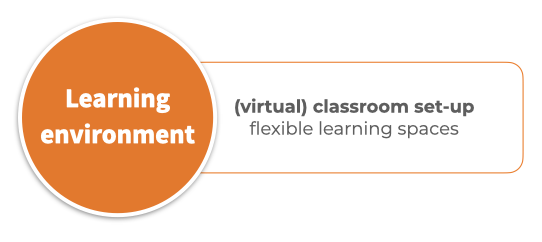There is no unique way of defining what Differentiated Instruction (DI) looks like, especially in Higher Education. The DI framework is mostly adopted in primary and secondary education, and helps teachers in being responsive to the different needs of their students.Why should a teacher or a trainer aim for DI in Higher Education? The main reason is that differentiated learning experiences enable engagement with content that is aligned with individual needs and preferences, leading to high and deep levels of thinking and understanding. Those needs and preferences can also depend on many factors, like gender, cultural background, economic conditions or disability. What we all face everyday in teaching is the fact that the Higher Education class, be it large or small, is - like any class - ultimately variable.
Differentiated Instruction will be addressed here referring mostly to the work of C.A. Tomlinson, who extensively researched and described the topic in many different books and articles (Tomlinson, 1999; 2005), also connecting it with the UbD theory we have learned about in the previous resource of this module (Tomlinson & McTighe, 2006).
It can be taken as a theoretical but also practical reference for developing our own strategies to address the variability mentioned at the beginning of this resource, for it “focuses on whom we teach, where we teach, and how we teach” (Tomlinson & McTighe, 2006, p. 3) and “is predominantly (although not solely) an instructional design model” (ibidem). In this inclusive approach, teachers ensure effective learning for varied individuals through processes and procedures, adopting multiple strategies that are recommended as effective for the achievement of common goals for all students.
In the works of C.A. Tomlinson differentiation is possible and recommended on four different levels:




A HE teacher can work on each of these aspects by considering and varying his/her proposals according to the readiness, interests or learning profile of the students (Chamberlin & Powers, 2010).
Differentiated instruction "is not synonymous with individualised instruction" (Chamberlin & Powers, 2010, p. 114). First of all, the teacher does not have to vary methods, content and objectives for each student. The limitations of such an individualised approach are obvious: it would be time-consuming, labour-intensive and ultimately utopian, especially as the class size increases. Moreover, such individualisation would lead to the total fragmentation of learning objectives to follow and meet the needs of individual students. Rather, differentiated instruction makes can rely on other strategies: the use of flexible group work, for example, but also the management of space, time and materials according to identifiable 'subsets' in the class group. This makes possible and encourages sustainable forms of individualisation and adaptation.
Secondly, again according to Tomlinson (2001), the teacher does not need to differentiate his or her teaching during each and every lesson. A plenary, face-to-face lesson for the entire group of students is used in a targeted manner, for those aspects where it may be necessary. This can and must be evaluated on the basis of the needs of the students.
But there is a third important aspect: differentiated instruction must not result in an unbalanced workload for students. Students with greater difficulties or gaps need not work harder - or less - than students with higher abilities and possibilities. The activities proposed must be of an appropriate level for them and must include elements such as the use of critical thinking, with the aim of being sufficiently challenging to motivate, not too complex so as not to demotivate.